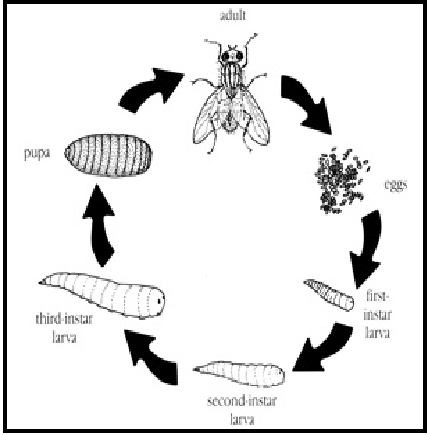Flies for Animal Food
Flies from pupae
Maggots as food
Adults for food
Rearing conditions
Raising Adult Flies for Feeding Insects or Pets
Insect life cycle
Flies go through a complete metamorphosis: egg, larva, pupa, adult. Flies are sold as pupae because they are easy to ship in this resting phase.

Time Flies Need to Develop
Temperature affects how fast insects develop. The warmer the conditions, the faster they develop, up to 100º F. Flies emerge from their pupae in 3 days at 80º F and in 5 days at 60º F. After being stored in your refrigerator for a while they take longer to emerge. After cold storage for several weeks flies emerge in 5-6 days at 80º F and 7-9 days at 60º F.
Conditions to Raise Flies
The best conditions for your flies to emerge is 80º F and 50% to 60% relative humidity (RH). Putting them into a warm place is referred to as incubating the pupae. A box or place with these conditions is called an incubator You can find a warm spot in your house or set up a box with a small light in it to warm. If the creature you are feeding the flies lives in a warm terrarium you may be able to place a dish or container in the terrarium and put fly pupae in it to emerge. A dish up off the ground is best, such as a dish suspended from a suction cup attached to an aquarium wall. After some experience you will find how fast the flies emerge in your conditions.
Small containers for holding fly pupae until they emerge can be take-out food containers like you get a sauce in. larger containers can be canning jars with gauze or mesh over the top held on with a rubber band or a canning jar ring. You may be able to put pupae in a sandwich bag, blow air into it and close it with a twist tie - like a small balloon. You can then transfer the flies from the container into the cage with the creatures you are raising. Make sure that there are no small holes in the cage that will allow the flies to escape.
How to Raise Flies
You will get a bag of about 5,000 fly pupae with wood shavings. The wood shavings keep the pupae from being squashed together in shipping. Take out a few pupae to incubate and put the rest in a refrigerator. Make sure they are in a part of the refrigerator that does not freeze. If you want 10 flies a day, take 15 flies out each day for the first week. Put the pupae into your incubator. For the second and third week take out 20 flies each day and put into your incubator. In the forth week take out 30 flies each day. As the flies are stored less and less will emerge. This will give you an idea of what to expect, but conditions vary so you will have to see what happens in your own home.
What To Expect From Stored Fly Pupae
Weeks in storage |
Percent hatch |
to get 10 flies incubate |
days to emerge at 60 F |
days to emerge at 80 F |
none |
95% |
11 pupae |
5 days |
3 days |
1 |
80 - 90 |
15 |
|
|
2 |
50 - 70 |
20 |
|
|
3 |
|
|
|
|
4 |
30 - 50 |
30 |
7 - 9 |
5 - 6 |
5 |
10 - 20 |
100 |
|
|
Maggots as replacement for mealworms
Fly larvae or maggots are collected as they are about to pupate. These can be shipped overnight to you for use for several days for feeding birds, reptiles and larger insects. Hold in a tray in a refrigerator or cooler with ice packs. Bring some out to room temperature and they will wiggle around and attract predators. Even at lower temperatures they will start forming into pupae. These can then be used to feed as adults.
Adult flies as food
Flies are collected as adults from part of our process and can be shipped in paper bags or cartons. The bag can be placed in a refrigerator for a few minutes to slow down the flies. The bag can then be opened and a number of flies dumped into a cage to feed an animal. Make sure that the cage has fly screen on the top and sides to contain the flies. A mixture of powdered milk and sugar can be sprinkled into the bottom of the bag to feed the flies, and use a cap or jar lid with a piece of damp sponge or paper towel to supply water.
Rearing Conditions
At Rincon-Vitova we rear house fly larva on a mixture of bran, milk and live yeast. Everything we use is acceptable for feeding animals. Adult flies are fed a mixture of milk, sugar and soy flour.
|

